
views
- Feed deer specially formulated deer food mixes for an easy option. Supplement feed mixes with fresh produce and oats.
- Stick to feeding deer in the harsh winter months when their natural food sources become scarce. Feed them consistently since they may come to rely on you.
- The best long-term way to feed deer is to improve their habitat so they have readily available food sources year-round. Plant trees, shrubs, and herbs for local deer.
What to Feed Deer

Go with formulated deer food mixes for an easy option. These mixes can typically be found at feed mills or pet supply stores. Deer feed mixes are usually a mix of alfalfa, oats, soybeans, molasses, and several vitamins and minerals. This type of food is easy for deer to digest, making it ideal for feeding.
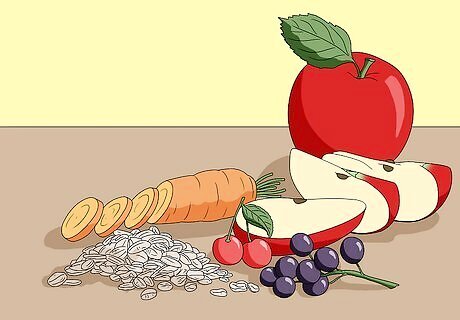
Supplement deer food mixes with oats and fresh produce. If formulated deer food mixtures are unavailable, oats are the next best supplemental food for deer. Oats provide deer with a healthy mixture of fiber and carbohydrates without disrupting their digestive system. Produce like apples, grapes, cherries, pears, carrots, and snap peas are eaten by deer in nature, so go with whatever is in season in your area in the spring and summer months. Acorns are a safe and natural food source that deer enjoy in the fall and winter months.

Cut down tree branches to feed deer for a cheap and safe option. In nature, deer eat twigs and other natural forest vegetation. To provide them with more of their natural food source, cut down branches that are out of their reach. This is one of the safest and most natural ways to keep deer fed throughout the year. White tailed deer prefer the following trees/shrubs: white cedar, birches, aspens, American yew, hemlock, maples, ash, white pine, mountain ash, scarlet elder, sumac, witch-hobble, and high bush cranberry. Avoid beech, balsam fir, spruces, and larch (these are unpalatable, indigestible, or both). Scatter cut limbs in areas where you've spotted deer before (or put limbs in areas where you'd like to attract deer).
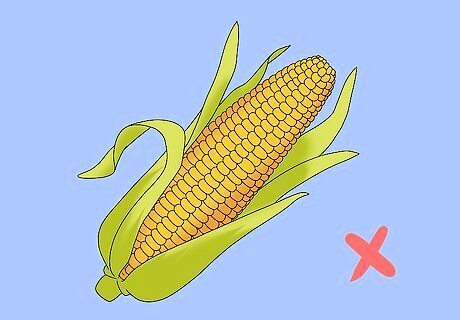
Do not feed deer a corn diet. A deer's digestive system is complex, and corn happens to be one of the worst types of food for them. Unfortunately, many deer end up extremely sick or dead because animal lovers believe that corn is good for deer. When deer are offered a sudden supply of corn, they aren't able to adjust to the high carbohydrate diet, and they end up dying. Since deer typically eat woody vegetation found in forests, don't feed them foods that are rich in fats and carbohydrates.
When to Feed Deer

Feed deer during the winter months. Since deer's natural food source is made up from woody vegetation, it becomes harder for them to find food during the winter. This is the reason many people choose to feed deer. If you decide to feed deer during the winter months, be careful to feed them the proper types of food and slowly introduce it into their diets. Twigs, buds, and leaves of woody plants such as elms, honeysuckle, raspberry, black cherry, basswood, grape, and hawthorn are great choices. Leaf buds and evergreen leaves are especially important during winter in northern states.

Introduce new food to deer slowly so their systems can adjust. It takes deer 2-4 weeks to adjust to a new diet, so start feeding them any new foods gradually. Slowly introduce new types of food by combining them with their natural diet of woody vegetation.
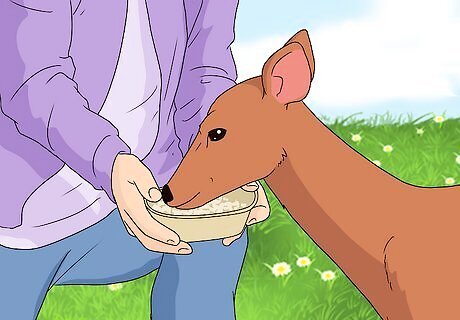
Feed local deer consistently rather than sporadically. When deer are fed by humans, they can easily become dependent and stop foraging for food naturally. If you feed deer and then suddenly stop (even if you've simply run out of food temporarily), the deer may go hungry, start bothering you for more food, or become aggressive. Once spring comes, wean deer off of supplemental food so that they can begin foraging for food on their own again. Keep in mind that year-round supplemental feeding is very controversial because it can be unsafe for deer and spread disease. Many wildlife organizations urge people not to do it and some states have made it illegal.
Where to Feed Deer
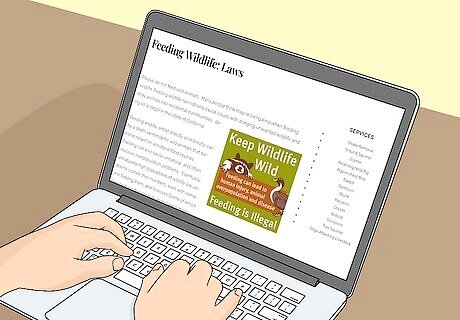
Make sure it's legal to feed wild animals in your area or state. Feeding wildlife is often regulated by local laws and wildlife commissions, and laws vary from state to state. Some states allow feeding between certain dates and prohibit it between other dates. Others have laws that dictate how much you're allowed to feed deer. Many states have outlawed feeding deer altogether, so it's important to check. To find out your local laws, check government wildlife and forest websites for your state.
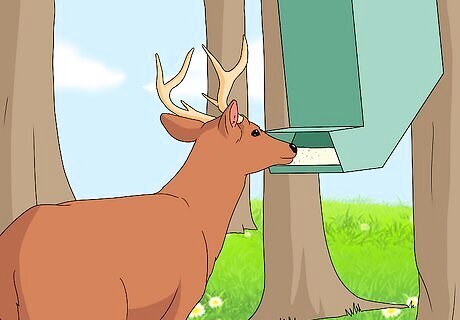
Set up deer feeders or troughs in your yard or on your property. Put the feeders or troughs as far away from your home as possible since close proximity can result in property damage. Keep feeders or troughs full at all times in the winter, or stick to a set feeding time each day. Early morning or sunset are good times for feeding. An adult white-tailed deer eats about 5-7 pounds of food per day. Try to avoid interacting with the deer since this makes them less fearful of humans, and more likely to become prey.

Find a legal and public location where you can feed deer. Many local wildlife organizations set up feeding sites for deer – these are public places where deer can come to feed. Bringing food to these sites helps feed deer without you having to take on full responsibility of feeding local white-tails. These organizations know the proper times to feed deer and the right amount of food to give them.
Improving the Natural Habitat
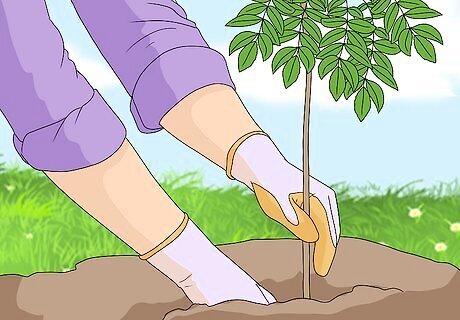
Plant trees and fresh produce to provide natural food sources for deer. This is a more natural way to feed deer and reduces the amount of daily feeding maintenance for you. Planting trees also helps the environment in general (which is always a nice bonus). Plant fruit trees (like apple trees), maple trees, or aspen trees on your property if you want to provide natural resources for deer.
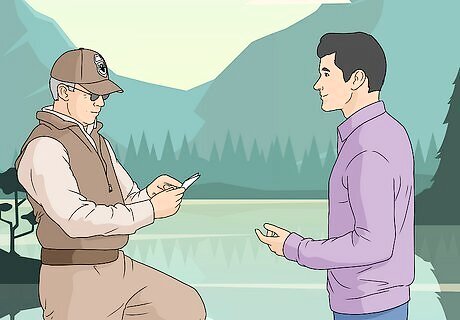
Get involved with your local wildlife agency. Getting involved with your local wildlife agency will allow you to help deer and other local wildlife the best way possible. Dealing with professionals is a great way to make a difference and actually help wild animals in the long-term. Contact your state wildlife agency or conservation organizations for more information.
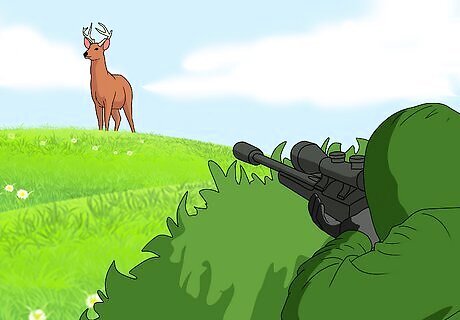
Allow deer hunters on your land if your area is overpopulated. If you live on hunt-able land, allow hunters to use your land during hunting season. Many rural areas are overpopulated with deer, which is why they face food shortages. Hunting keeps deer populations in balance with their available habitat, and minimizes the negative impacts on deer habitat, farmers, residents, and motorists.




















Comments
0 comment